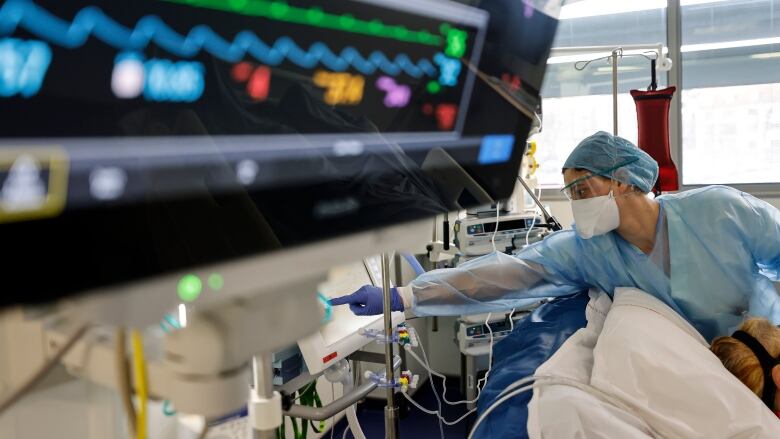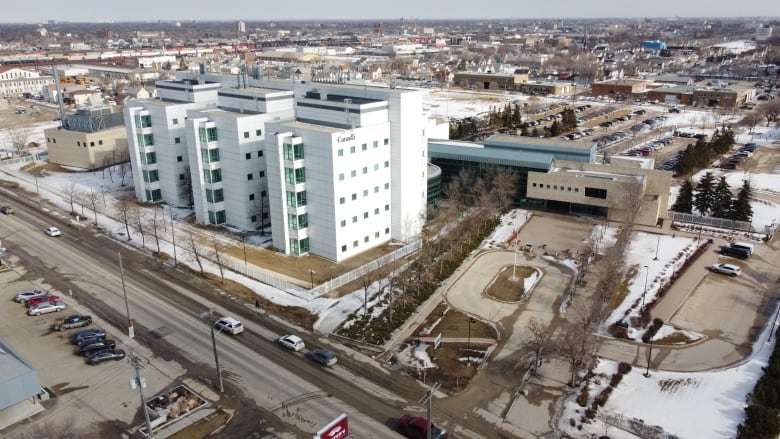What signs can Manitobans watch for to know when the Omicron wave is cresting?
With limited access to testing, hospitalizations and wastewater surveillance increasingly important: experts

Health experts can no longer rely on case numbers and test positivity as reliable indicators of the progress of the COVID-19 pandemic so what data will help them determine what's to come?
Hospitalization numbers, intensive care unit admissions, the length of hospital stays, staffing levels and absences, and wastewater testing should all be tracked to gauge how Manitoba is faring as the Omicron variant overwhelms testing capacity, somehealth-care professionals say.
"In a scenario where there's a total admission that the system was overwhelmed ... the test positivity rate, what does it really reflect? [It's] very difficult to know what it reflects, " said Dr. Eric Jacobsohn, a Winnipeg ICU physician.
Case counts have become increasingly meaningless, and test positivity rates which measure the percentage of completed tests that come back positive for COVID-19 are compromised because of limited access to PCR testing, said Jacobsohn.
The five-day test positivity rate, once the key indicator for pandemic watchers and one still used by some experts, has become less reliable as the province has restricted access to PCR testing,the only form of testing officially recorded in Manitoba.
"That test positivity rate is still built on the PCR, and a lot of people are using the rapid tests, which aren't as accurate and aren't reflected in the so-called official counts," said Kevin Coombs, a medical microbiologist at the University of Manitoba.
While public health officialsregularly publish a range of COVID-19 data,hospital and ICU admissions are among the only useful pieces of information for those searching for signs that the Omicron wave has crested, Jacobsohn said.
Track staffing levels:epidemiologist
Manitoba's reported COVID hospitalizations have risen every day for the past four weeks, with the exception of Friday, when the number dropped by one to 664.
Similarly, the number of ICU patients has risen steadily over that time, doubling from 25 on Dec. 27 to 50 on Friday.
There are a number of other indicators that health researchers and government officials can use to gauge the severity of the pandemic. However, not allare easily accessible to the public, and it's unclear how much public health officials in Manitoba use them.
University of Saskatchewan epidemiologist Nazeem Muhajarine also said it's important to focus on hospitalizations and ICU admissions but another key indicator is how long people infected with the virus spend in hospital and intensive care units.
A recent study looked at health outcomes of nearly 70,000 COVID-19 patients in California. The preliminary scientific paper, which was posted to the medRxiv server, found that the medianlength of time Omicron patients stayed in hospital was 3.4 days less than those infected with the previous Delta variant.
Muhajarine said officials also need to track staffing levels and the number of COVID-related absences in health care and other key services.
"We are seeing a thinning of our staffing complement in our hospitals," he said, even asmore patients cometo hospitals in need of care.
Although the Manitoba government has released statistics on staff absences in some sectors and length of hospital stay for COVID patients in the past, these indicators are not reported in the province's regular bulletins or online dashboard.
Wastewater surveillance
An indicator that could become increasingly important comes from testing the viral load in wastewater.
It can take a few days between when a person becomes infected with the coronavirus that causes COVID-19 and when they test positive, but people begin to shed viral material into the sewers on the day they become infected, Muhajarine said.
Measuring the amount of viral material in wastewater "gives us a whole picture of the spread of the virus at any given time, at a given place," he said.
If monitored over time, it can give an indication of whether cases are increasing or decreasing.
Coombs said wastewater testing can give an average of the number of infections at a population level, but it won't provide a clear picture of the number or severity of infections.
"The amount of genome that is picked up could reflect either low-level infection in a lot of people, or it could be a high-level infection in a very small number of people," he said.

The Public Health Agency of Canada has been collecting wastewater samples from across the country, with testing at public health labs, including the National Microbiology Laboratory in Winnipeg.
The agency has collected samples from three sewage treatment plants in Winnipeg, in partnership with local public health, a spokesperson said.
PHAC did not provide information on the results of sampling at the Winnipeg sites, but said samples collected from those sitesare sent to theNational Microbiology Labforanalysis.
Those results "are provided to theprovince of Manitoba for their interpretation twice weekly," according to a statement from PHAC.
When asked if it was involved in any wastewater testing, a spokesperson for the Manitoba government referred to the National Microbiology Laboratory study, but said provincial staff have not participated in the investigation.
No one indicator will tell people clearly when this wave of the pandemic is over, Coombs said. While hospitalizations and ICU capacity are important, so is the total case count.
"If there's high levels of infection in the community, that's going to give the virus greater chance to mutate and for the next variant to come along."












_(720p).jpg)


 OFFICIAL HD MUSIC VIDEO.jpg)
.jpg)



























































































